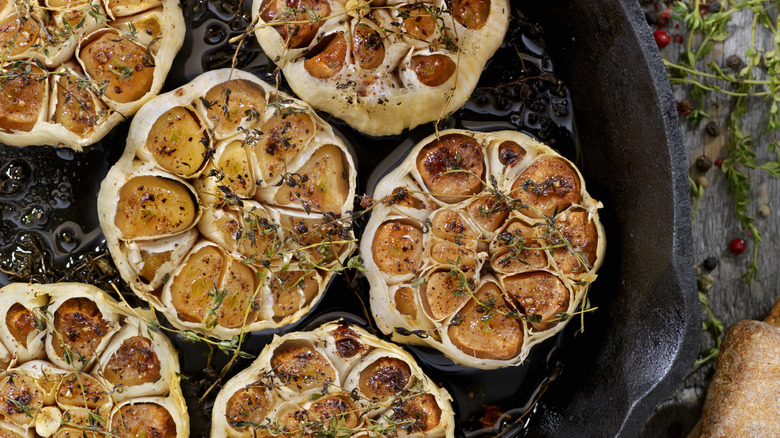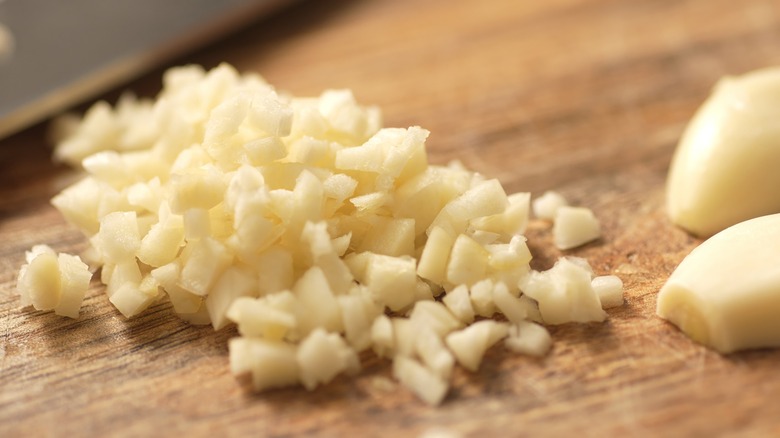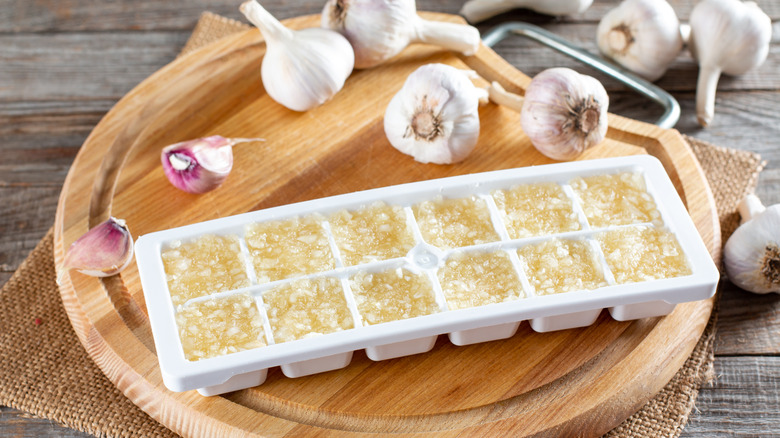How To Store Garlic, Roasted Or Fresh
Garlic is a low-maintenance kitchen staple with a fairly long shelf life, but even so, the beloved allium is not immune to inevitably spoiling with time. Ultimately, freshness boils down to storage. Keep it properly, and you'll have fresh garlic for days. But improper storage can just as quickly cause the same allium to sprout, shrivel up, turn mushy, and rot — or worse yet, cause its buttery, pungent flavor to turn tragically sharp and bitter. And who wants that?
The best way to store fresh garlic is to leave it intact in bulbs. Don't break it, don't pull it apart, and definitely don't peel or chop it until the very last minute. Pop the bulbs in a paper bag, a basket, or in any container with plenty of air circulation, and leave that in a cool and dry place at room temperature, away from direct sunlight or moisture. Kept this way, whole garlic bulbs will stay fresh for anywhere between two to six months.
In comparison to whole bulbs, roasted heads of garlic will only stay fresh for four days in the refrigerator in an airtight container. That said, there is a way to slightly extend its lifespan. Instead of storing a bulb of roasted garlic on its own in the fridge, make sure to cover it in olive oil first. Doing so will help keep the allium fresh for two weeks.
Refrigerate peeled and chopped garlic
Garlic's lifespan rapidly decreases as soon as the cloves are broken off from the bulb. Your best shot here is to leave these cloves unpeeled and keep them at room temperature in containers with plenty of airflow. Use them up within two to three weeks before they dry out, or throw them all together into a chicken with 40 garlic cloves recipe.
Peeled, minced, grated, or sliced garlic is best kept in the refrigerator where it will stay fresh for up to a week. Just make sure to put everything into an airtight container. Garlic has a notoriously strong flavor and odor, which can quickly transfer to other foods. You could even cover the peeled or minced allium in oil to keep its pungent flavor and color intact, but it's best to use it up within a week regardless. Additionally, you'll want to be careful that the oil-covered garlic is kept at a constant 40 degrees Fahrenheit or lower, as it can quickly develop botulism otherwise (per the USDA).
Toss the garlic out if it looks moldy or rotten, or if it feels too soft or mushy to the touch. Green, yellow, or brown spots of discoloration are another sign of garlic past its prime. It's also best to throw it away if it has begun to sprout. Although you can safely use sprouted garlic, its bitter flavor will leave much to be desired.
Freeze garlic to keep it fresh for longer
A great way to extend garlic's shelf life is to store it in the freezer. One way to do so is to peel a whole head of garlic and line the cloves in a single layer on a tray before placing that in the freezer overnight. Transfer the cloves into an airtight bag later, and then store that in the freezer for six months to a year.
Another way to freeze garlic is to mince it or turn it into a paste first. Then, scoop everything into an ice cube tray and freeze it until it solidifies. You could even top these cubes with a bit of oil and salt, so they're ready to go straight from the freezer and into the pan when it's time to cook. Keep these garlic cubes in an airtight container in the freezer and use them up within a year at most.
Even roasted garlic can be kept in the freezer to extend its shelf life to six months. Either pop the entire bulb straight into a sealable plastic bag or break off each clove and freeze it individually on a tray before transferring that into an airtight container. The only thing to keep in mind is that frozen garlic will have a more muted flavor and that its firm texture will soften up a bit. However, it's nothing to worry about: You most likely won't notice any difference once it's cooked.



